
A new study reveals that when people see objects, their brains think in many dimensions at once, not just by categorizing what they see.
This challenges the traditional view that the main goal of human perception is to recognize objects and place them into categories, like identifying a dog as an animal.
Researchers from the Max Planck Institute for Human Cognitive and Brain Sciences, Justus Liebig University, and the U.S. National Institutes of Health have shown that this perspective is incomplete.
The study, published in Nature Human Behaviour, demonstrates that brain activity when observing objects can be explained by a variety of behaviorally important dimensions, not just categories.
Until now, scientists thought that the brain’s visual system broke down objects into basic features and then reassembled them for recognition.
However, the study shows that recognizing and categorizing objects is just one part of a much more complex process.
“Our findings reveal that categorization is important, but it’s not the only goal of vision,” says Martin Hebart, the study’s senior author and a professor at Justus Liebig University.
“We discovered that our visual system captures a wide range of behaviorally relevant dimensions at all stages of processing.”
Using a computer model, the researchers identified 66 different object dimensions based on the behavior of more than 12,000 participants. These dimensions go beyond simple categorization, covering features like colors, shapes, and more subtle qualities, such as how typical a dog is of an animal.
This new understanding of perception was tested in an experiment where brain activity was measured in three participants as they viewed more than 8,000 images of 720 different objects over 15 sessions in an MRI scanner. The researchers found that when participants saw a rocket, for example, their brain activity reflected not only that it was a rocket or a vehicle, but also that it was gray, elongated, related to fire, and capable of flying.
“All stages of the visual system contribute to capturing a wide range of behaviorally important features that make up our perception,” explains first author Oliver Contier.
Hebart adds, “Our research reveals that we perceive the world in a multidimensional way, which better explains how we understand and interact with our surroundings.
This approach goes beyond the idea of categorization and helps us understand the rich variety of human behaviors.” This broader understanding of perception could have important implications for future research on how we interact with the visual world.
If you care about brain health, please read studies about how the Mediterranean diet could protect your brain health, and blueberry supplements may prevent cognitive decline.
For more information about brain health, please see recent studies about antioxidants that could help reduce dementia risk, and Coconut oil could help improve cognitive function in Alzheimer’s.



